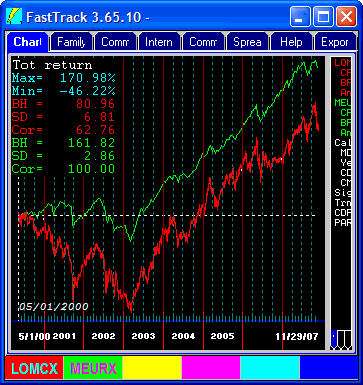
Risk Assessment
Updated
01/31/14
How Much Risk is Appropriate for Me?
At the very extreme ends of the risk spectrum there are strategies whose risk is impossible to
evaluate. For example,
- Is burying gold and freeze-dried food in a vault in your backyard a good investment considering the possibilities of nuclear holocaust,
global warming, resurgent communism, and asteroid impact? The probability of such disasters is so
low, that there is no mathematical way of determining return/risk ratio. Any return at all
would produce an astronomically high ratio.
- At another extreme, how risky
is it to invest in cocaine distribution? The likelihood of disaster is so high, that no return
would be enough.
At extremes it is impossible to quantify risk/reward on a rational
basis.
More in keeping with reality, it is assessing the risk/return of shorting
stocks vs. sitting in money market is still hard to compare What are your chances of picking the market top? What
are the chances that inflation will eat up all your money market dividends?
Since most folks don't understand the risks of being 100% in money or 100%
short. they choose investments that occupy a broad middle ground of risk/return.
They buy and hold broad-based mutual funds or diversified portfolios of established stocks and
bonds. These investors are comforted by the belief that they'll be doing no worse (or better) than most
everyone else. The ultimate expression of this philosophy is to buy an S&P 500 Index
Fund like VFINX.
FastTrack is not going to make you crazy!
FastTrack is aimed at those who ARE CURRENTLY buying and holding ordinary portfolios. FastTrack
will encourage you to improve your risk/return ratio by regularly shifting your diversified
portfolio among ordinary investments, mutual funds, ETF, and blue chip stocks. FastTrack
provides tools and methods to quantify risk/return.
FastTrack will do the following:

- Help distinguish between risky from conservative investments. . . it is amazing how many
nonFastTrackers think gold funds are a low risk investment.
- Show the difference between good management and bad. Compare MEURX with LOMCX. Both have
well-known maverick managers determined to achieve maximum return. In this case more
volatility DOESN'T pay.
- Let you know what is high and what is low . . . Name any stock or fund and most
"investors" will have difficulty telling you if it's currently nearer its
52-week high or 52-week low.
- Show where institutional market players are making trades that shift the relative strength
of market sectors. FastTrack is designed to
take advantage of rotating markets.
- Provide a context in which to evaluate investment advice. Too often the financial press
reports what was hot last year as if it were the best place to be this year. Is the
writer a true guru or merely a historian?
- Illustrate investing, just not in the same issues all the time. FastTrack shows how to
diversify over time instead of passively allocating by sector.
- Encourage you to be invested fully at all times and NOT to market time.
When using FastTrack to improve your investing, you should expect to do several percent better per year
than before. expect this improvement year-after-year in
a consistent progression toward your goals. You should find that FastTrack works better
and better over the years as you more clearly hone your goals and strategies. FastTrack
makes no promise of instant wealth trading high-risk issues. You will get rich slowly using time
honored allocation strategies.
Common Strategies and their Associated Risks
Editors note: This section written in early 1998 and has not be revised
since then.
Invest in an Index Fund: This is the strategy that millions of
investors are following. Month by month their 401K or other retirement money pours into
these funds. There is no management by either the fund company or the investor.
Inevitably, this strategy like ALL strategies followed by everyone must fail.
There are two scenarios:
- There will be (has been) a speculative bubble which runs these funds to absurd
heights. These funds will sharply correct losing perhaps 20%-40% of their value.
Thereafter, it may take 5-10 years to recover former highs.
- The funds will continue upward until baby boomers begin to retire in the year 2012. The
S&P 500 will go flat or decline through 2015 as baby boomers liquidate their
investments. Eventually, these investors will cascade into capitulation causing a major
crisis in which they will lose 50% of their assets at an advanced age.
The solution for savvy investors will be to diversify into markets that are unaffected
by baby boomers. Likely these markets will be what we call emerging markets in 1998. These
economics will supply low cost, quality products to the US economy which in 2010 will the
dominated by service industries, not manufacturing. Emerging markets are volatile and as
of 1998 are suitable only for those actively managing their money. There will be
opportunities both in foreign equities and debt. See the BD-INTLJ Family.
The Solution is Active Management.
Hold the good companies only while they're good. There is a right time to sell and a
right time to buy. You need only trade a few times a year or less. FastTrack will help you
do that.
 Taking too Much Risk: A middle-age investor only needs to do 2-3%
better annually than average to be a millionaire. Most do fine with mutual funds instead
of more risky stocks. Everyone will do better avoiding options and futures.
Taking too Much Risk: A middle-age investor only needs to do 2-3%
better annually than average to be a millionaire. Most do fine with mutual funds instead
of more risky stocks. Everyone will do better avoiding options and futures.Too
Much Risk Defined: When you feel that you must buy or sell everything
NOW, then your strategy has failed. You will likely be squeezed out at The Very Bottom
making the BIG MISTAKE.
The Very Bottom Defined: This is the point where the last poor,
suffering risk-taker finally capitulates and sells.
The Very Top Defined: This is where you buy because you just can't
stand being on the sidelines any longer. Usually, this sudden courage is brought on by
listening to an expert on TV urging you to buy the
stocks . . . that he is selling. |